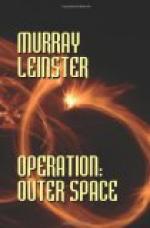He went back to the business at hand. Some two years before there had been a fake corporation organized strictly for the benefit of its promoters. It had built a rocket-ship ostensibly for the establishment of a colony on Mars. The ship had managed to stagger up to Luna, but no farther. Its promoters had sold stock on the promise that a ship that could barely reach Luna could take off from that small globe with six times as much fuel as it could lift off of Earth. Which was true. Investors put in their money on that verifiable fact. But the truth happened to be, of course, that it would still take an impossible amount of fuel to accelerate the ship—so heavily loaded—to a speed where it would reach Mars in one human lifetime. Taking off from Luna would solve only the problem of gravity. It wouldn’t do a thing about inertia. So the ship never rose from its landing near Lunar City. The corporation that had built it went profitably bankrupt.
Cochrane had been working feverishly to find out who owned that ship now. Just before the torp-test he’d mentioned, he found that the ship belonged to the hotel desk-clerk, who had bought it in hope of renting it sooner or later for television background-shots in case anybody was crazy enough to make a television film-tape on the moon. He was now discouraged. Cochrane chartered it, putting up a bond to return it undamaged. If the ship was lost, the hotel-clerk would get back his investment—about a week’s pay.
So Cochrane had a space-ship practically in his pocket when the public demonstration of the Dabney field came off at half-past 203 o’clock.
The site of the demonstration was the shadowed, pitch-dark part of the floor of a crater twenty miles across, with walls some ten thousand jagged feet high. The furnace-like sunshine made the plain beyond the shadow into a sea of blinding brightness. The sunlit parts of the crater’s walls were no less terribly glaring. But above the edge of the cliffs the stars began; infinitely small and many-colored, with innumerable degrees of brightness. The Earth hung in mid-sky like a swollen green apple, monstrous in size. And the figures which moved about the scene of the test could be seen only faintly by reflected light from the lava plain, because one’s eyes had to be adjusted to the white-hot moon-dust on the plain and mountains.
There were not many persons present. Three jeeps waited in the semi-darkness, out of the burning sunshine. There were no more than a dozen moon-suited individuals to watch and to perform the test of the Dabney field. Cochrane had scrupulously edited all fore-news of the experiment to give Dabney the credit he had paid for. There were present, then, the party from Earth—Cochrane and Babs and Holden, with the two tame scientists and Bell the writer—and the only two reporters on the moon. Only news syndicates could stand the expense-account of a field man in Lunar City. And then there were Jones and Dabney and two other figures apparently brought by Dabney.




